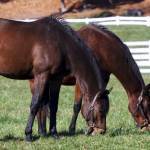Function and Health of the Horse’s Cecum and Large Intestine

The horse’s digestive system is made up of several organs, each of which provides an important function in digesting and utilizing the nutrients that are in the feed and forage ingested by the horse. Anything the horse eats goes first to the stomach and then to the small intestine. Material not digested in the small intestine passes through the ileo-cecal orifice into the cecum and then to the large intestine.
The cecum and large intestine (hindgut) house billions of bacteria and protozoa that enable the digestion of cellulose and other fibrous fractions of the feed. From microbial fermentation of feeds, the horse is able to derive energy and other nutrients. Energy is constantly available to the horse in the form of volatile fatty acids from this soup of microbes and fiber found in the hindgut. Additionally, these hindgut microbes synthesize B vitamins and vitamin K, which are available to the horse to help meet its requirements for these nutrients under normal circumstances. A significant amount of microbial protein is also synthesized in the horse’s hindgut.
The health and vitality of these essential microbes is dependent on the proper acidity or pH of this part of the intestinal tract. Large fluctuations in the pH can cause changes in the population of microbes, which can ultimately interfere with nutrient utilization in the horse. Feeding large grain meals can strongly influence this portion of the digestive tract by lowering the pH. Chronic exposure to low pH in the cecum predisposes the horse to anorexia and other metabolic disturbances. Interestingly enough, horses consuming high-concentrate, low-forage diets also spend more time chewing wood and practicing coprophagy (eating of manure) than do horses on mostly forage diets. This may be an indication that the low pH causes discomfort, and the horse tries to remedy the situation by attempting to get more fiber in its diet.
Normal pH in various regions of the equine digestive tract are stomach (nonglandular), 5.4; stomach (glandular 2.6); small intestine, 7.4; cecum, 6.6; and small colon, 6.6.
In the worst-case scenario, a sudden drop in pH in the hindgut from the fermentation of an excessive amount of starch, such as when a horse accidentally gets into the grain bin, can have catastrophic effects. The drop in pH kills off the fiber-digesting bacteria, release an endotoxin as they die. This endotoxin gets into the bloodstream and can cause laminitis and colic.
Obviously, keeping a feeding program as close to the natural manner in which the horse evolved would minimize the effect on the delicate balance of the microbial population in the hindgut. Radical departures from small continuous meals consisting of predominantly forage result in detrimental effects on gut function and stability. Horses on an all-forage diet will not experience wide fluctuations of pH in the cecum and large intestine that can be experienced when large amounts of grain are added to the diet. The effect of grain on the pH can be minimized by feeding smaller and more frequent grain meals and keeping forage available to the horse at all times.
Another advantage to keeping the hindgut full of forage is that it allows the hindgut to be a storehouse of water and electrolytes for the horse. The presence of fiber in the diet will also increase the water intake of the horse. During exercise when dehydration may be an issue, such as distance riding, a good supply of fiber in the hindgut will help to keep the horse hydrated and supply him with electrolytes that are lost in sweat. However, during competitions, the long duration of exercise and environmental factors can so deplete the horse of water and electrolytes that the animal cannot get enough from the hindgut without additional supplementation. This storehouse also adds weight to the animal, so for short-term sports where quick bursts of energy are needed, reducing the amount of fiber in the gut may be appropriate prior to the competition. A note of caution: this practice is not ideal on a day-to-day basis and should only be considered an option for competitions.








